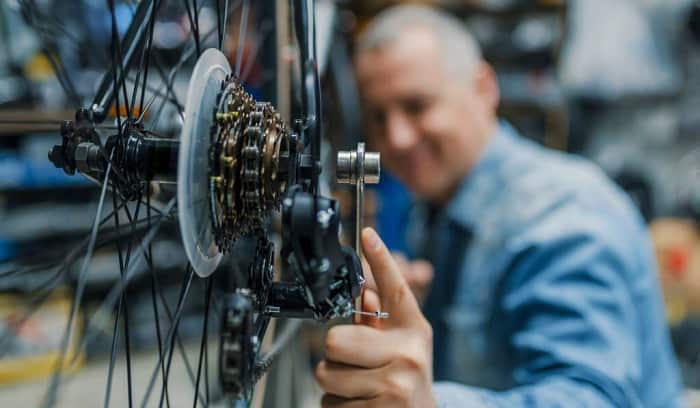In order to run your bike at its full capacity, learning to shift gears is crucial. Gears are mechanical wonders that allow you to control your speed while on the road. It even lets you ride the bike on steep mountains or difficult terrain without putting in too much effort.
However, for beginners, confronting the complexity of bike gears is a challenge. So, how to shift gears on a bike for dummies? Well, it is important to inspect your bike gears, learn the basics, and understand the right timing in shifting gears.
Table of Contents
Inspecting Your Bike Gears
Bike gear typically comes with front gears and rear gears to indicate whether your bike has a single-speed gear or multiple-speed gear. Knowing the numbers is crucial, so you can operate and switch gears on a bike more effectively:
Front gears – When inspecting the number of your front gears, take a look at the pedals, particularly the center part. You should see one or several toothed metal rings sitting onto the chain. The metal rings you see are the front gears and can range from 1 to 3 rings.
Rear gears – Next is knowing the number of your rear gears. You can check the bike rear wheel to see the chain that runs from the front gears up to the middle of the back wheel. You must count the sets of rings that the chain runs over, too. Most bikes have 12 rear gears.
After knowing the numbers of both the front and rear gears, multiply them. If you have 3 front gears and 9 rear gears, your bicycle is a 27-speed equipment.
Learning the Basics
Now that you know how many speed options your bike has, it is essential that you learn how to use them. Each gear has a dedicated function. For instance, front gears are for left-hand shifters while rear gears are for right-hand shifters.
1. Left-hand shifters
Normally, when you press the left-hand shifter, you are controlling the movement of your front gears. Once you use the left-hand shifters, the derailleur will automatically move the chain sideways to catch up with the front gear. When this happens, your front gear displays a huge shift in the bike gear ratio.
2. Right-hand shifters
Meanwhile, right-hand shifters are used to control the rear gear. Once you press the right-hand shifters, the rear derailleur will instantly move sideways to catch up with the back gear. The gear will only display a slight shift over the gear ratio unlike when using the left-hand shifters.
3. Gearing down
Gearing down or downshifting means switching the equipment to low gear. Cyclists usually resort to downshifting when preparing for a climb. Downshifting enables you to pedal smoothly even when climbing up a hill. It makes pedaling more straightforward and less power-demanding. Gearing down means shifting into a smaller front gear or shifting into a bigger rear gear.
4. Gearing up
In contrast, if you want to speed up your movement, you will need to gear up or upshift. For this process, you have to pedal harder and switch to the high bicycle gear.
Know When to Shift Gears
1. Starting or stopping
Launching your bicycle with a few pedals can be challenging for some. It is the time your equipment changes from a stationary position and goes to a particular speed. So, it is crucial that you begin with a reasonable low gear, then shift to build your cycling speed.
If you need to stop due to a traffic light, use the low gear again. In this way, it will be easier to start biking once the light turns green.
2. Speeding up
If you are in a competition or want to speed up your cycling speed, you have to launch from low gear, then shift your gear up gradually as you progress. In this way, you can build up acceleration without putting too much strain on your leg muscles.
For flat terrains or highways, using a middle gear is ideal.
3. Riding on hills
If you want to go uphill in a stable and controlled manner, it is better to lower your gears. Changing gears on a bike to lower gears can give you more control on the bicycle, but at a lesser speed. You do not need to put in too much effort when using a low gear while climbing a hill.
4. Riding on downhill areas
Shifting or gearing up is the best way to go downhill or on level ground areas. Flat terrains will be easier if you shift to higher gears for a faster speed setting. It also means you have to pump up your bike by pedaling faster and more steadily.
Know How to Shift Without Damaging Your Bike
Gears can damage your bike if you use them incorrectly. The cracking and disturbing sound coming from your bike chain is an indicator that you are using the wrong gear. If this persists, you might damage several components of your bike.
In order to prevent this from happening, here are things you should know:
1. Avoid cross-chaining
Cross chaining means your bike chain is on the opposite cogs of the chain-ring or bike cassette. Bike chain should always follow a straight or linear line. When a chain sits on the opposite cogs, the chain easily wears out because of the stress it receives.
2. Avoid load bearing shift
Load bearing means you are putting too much force on your pedals while changing your gear. It usually occurs when you accelerate or riding uphill. Thus, it is important to change gear while gradually putting force on the pedals to prevent load bearing.
When this happens, you will hear loud cracks and delayed or imperfect shifting that can damage the chain, cassette, or even the chain-ring. Worse, there is a potential to chip a tooth on one of the cogs which can break the bike chain.
Conclusion
Bicycle gear can directly impact the level of performance of your equipment. You can navigate the road more easily if you have mastered the basics of how shift gears on a bicycle. Good thing, we have compiled all the necessary information here to help beginners like you on how to shift gears on a bike for dummies.
Now that you have the right knowledge, you can do a few practice runs and master shifting gears on a bike across different terrains.

“I ride my bike to work for years, but is that enough? Our carelessness towards our surroundings has taken a toll on the environment. And now, everyone is responsible for changes; even the most minor contribution is counted. With this hope and spirit, I started with my partner to establish Biketoworkday to help more individuals commute to their work sites on their bikes.”




